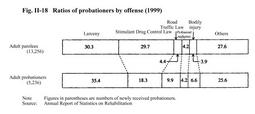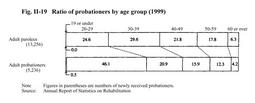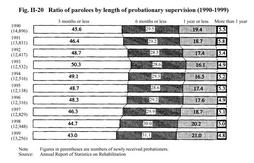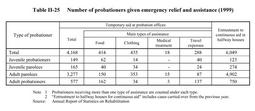| Previous Next Index Image Index Year Selection | |
|
|
2 Data on probation (1)Trends in probation cases
In this subsection, we will give an overview of trends in the number of probation cases, concentrating mainly on adult parolees and adult probationers (see Part 3, Chapter 2, Section 6 for juvenile probationers and juvenile parolees). Fig. II-17 shows the number of probationers newly received by probation office since 1980, divided into adult parolees and adult probationers (see Appendix II-12 ). Adult parolees have been steady at the 12,000 level recently, but in 1999 they increased by 308 (2.4%) from the previous year to 13,256 persons. Adult probationers have been on a par at around 5,000 since 1989. In 1999, they decreased by 46 (0.9%) to 5,236 persons. As for female inmates granted provisional release from women's guidance homes, no cases have been received in recent years. Fig. II-17 Trends in numbers of newly received probationers (1980-1999) Fig. II-18 shows the component ratios of newly received probationers in 1999, by type of offense. Larceny and Stimulant Drug Control Law violations accounted for high proportions of both adult parolees and adult probationers.Fig. II-18 Ratios of probationers by offense (1999) Fig. II-19 shows the number of newly received probationers in 1999 by age group. While 45.9% of adult parolees were aged 40 or over, 46.6% of adult probationers were aged 29 or under.Fig. II-19 Ratio of probationers by age group (1999) Fig. II-20 shows the number of newly received parolees over the last 10 years, by length of probation.Fig. II-20 Ratio of parolees by length of probationary supervision (1990-1999) (2)Data on probation treatment a Measures for probationers with good records The following measures (measures taken for good conduct) are implemented for probationers whose conduct is stable during the probation term and who are considered unlikely to commit repeat offenses. [1]Adult parolees Indeterminate sentence parolees who have served their minimum term are granted termination of indeterminate sentence, as if they had completed their sentences. [2]Adult probationers Provisional suspension of probation. As measures taken for good conduct in 1999, there were no cases of termination of indeterminate sentence(compared to 2 in 1998), but provisional suspension was granted to 569 probationers (606 in 1998) (source:Annual Report of Statistics on Rehabilitation). b Measures for probationers with bad records The following measures (measures taken for bad conduct) are implemented for probationers who have violated the conditions of their probation or committed repeat offenses, etc. , during the term of probation. [1]Adult parolees For probationers who go missing without permission, probationary supervision will be suspended to halt the progression of their sentences. Revocation of parole to return probationers to correctional institutions. [2]Adult probationers Revocation of suspension of execution of the sentence to send probationers to correctional institutions. [3]Women's guidance home inmates granted provisional release Revocation of provisional release to return probationers to women's guidance homes. As measures taken for bad conduct in 1999, 617 probationers were penalized with suspension of probationary supervision(compared to 654 in 1998), 927 with revocation of parole(927 in 1998), and 1,526 with revocation of suspension of execution of the sentence(1,608 in 1998) (source:Annual Report of Statistics on Rehabilitation). Meanwhile, probationers who fail to reside in a fixed abode, or give sufficient reason to suspect that they have violated the probation conditions and fail to respond when summoned by a probation office director, etc. , are apprehended with an arrest warrant issued by a judge. Then, following a decision to commence examination for bad conduct measures, they are detained in the appropriate institution for a fixed term. In 1999,including juvenile probationers and juvenile parolees, 181 probationers (compared to 179 in 1998) were apprehended in this way, and 133 (135 in 1998) were detained(source:Annual Report of Statistics on Rehabilitation). c Emergency relief and assistance When a probationer's rehabilitation could be hindered by illness, injury, the lack of a suitable abode or occupation, or other circumstances, probation officers and volunteer probation officers give advice and guidance so that the necessary support may be provided by public welfare facilities, etc. When such support is not immediately forthcoming, or when the support provided is considered inadequate, specific support is provided at probation offices. This is referred to as emergency relief and assistance. Emergency relief and assistance includes (1) temporary aid provided by the probation office, such the provision of food and clothing, medical treatment, payment of travel expenses to the place of next abode, and (2) continuous aid through entrustment to halfway houses and individuals. Table II-25 shows the number of probationers for whom such assistance was implemented in 1999. Table II-25 Number of probationers given emergency relief and assistance (1999) |




